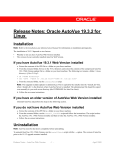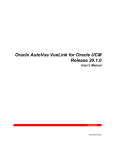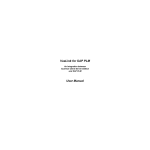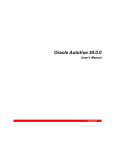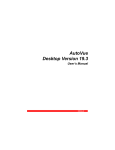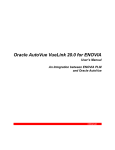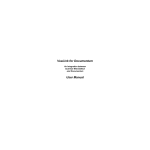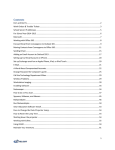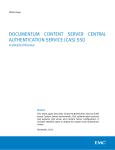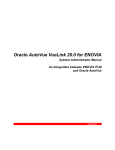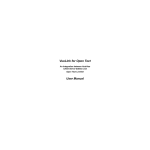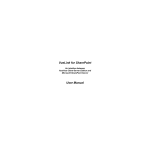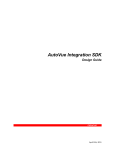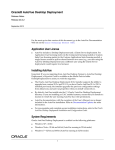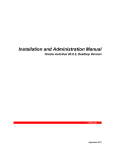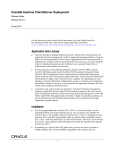Download User`s Manual - Oracle Documentation
Transcript
Oracle VueLink 19.3.1 for Documentum User’s Manual An Integration between Documentum and AutoVue Web Version Copyright © 1998, 2009, Oracle and/or its affiliates. All rights reserved. The Programs (which include both the software and documentation) contain proprietary information; they are provided under a license agreement containing restrictions on use and disclosure and are also protected by copyright, patent, and other intellectual and industrial property laws. Reverse engineering, disassembly, or decompilation of the Programs, except to the extent required to obtain interoperability with other independently created software or as specified by law, is prohibited. The information contained in this document is subject to change without notice. If you find any problems in the documentation, please report them to us in writing. This document is not warranted to be error-free. Except as may be expressly permitted in your license agreement for these Programs, no part of these Programs may be reproduced or transmitted in any form or by any means, electronic or mechanical, for any purpose. If the Programs are delivered to the United States Government or anyone licensing or using the Programs on behalf of the United States Government, the following notice is applicable: U.S. GOVERNMENT RIGHTS Programs, software, databases, and related documentation and technical data delivered to U.S. Government customers are "commercial computer software" or "commercial technical data" pursuant to the applicable Federal Acquisition Regulation and agency-specific supplemental regulations. As such, use, duplication, disclosure, modification, and adaptation of the Programs, including documentation and technical data, shall be subject to the licensing restrictions set forth in the applicable Oracle license agreement, and, to the extent applicable, the additional rights set forth in FAR 52.227-19, Commercial Computer Software-Restricted Rights (June 1987). Oracle Corporation, 500 Oracle Parkway, Redwood City, CA 94065. The Programs are not intended for use in any nuclear, aviation, mass transit, medical, or other inherently dangerous applications. It shall be the licensee's responsibility to take all appropriate fail-safe, backup, redundancy, and other measures to ensure the safe use of such applications if the Programs are used for such purposes, and we disclaim liability for any damages caused by such use of the Programs. The Programs may provide links to Web sites and access to content, products, and services from third parties. Oracle is not responsible for the availability of, or any content provided on, third-party Web sites. You bear all risks associated with the use of such content. If you choose to purchase any products or services from a third party, the relationship is directly between you and the third party. Oracle is not responsible for: (a) the quality of third-party products or services; or (b) fulfilling any of the terms of the agreement with the third party, including delivery of products or services and warranty obligations related to purchased products or services. Oracle is not responsible for any loss or damage of any sort that you may incur from dealing with any third party. Oracle is a registered trademark of Oracle Corporation and/or its affiliates. Other names may be trademarks of their respective owners. Oracle VueLink 19.3.1 for Documentum 3 Contents INTRODUCTION .........................................................................................................................5 Functional Overview .............................................................................................................................. 5 Why Does the Documentum User Need a Viewing and Markup tool? ............................................. 6 Markup File Management ..................................................................................................................... 7 Other Useful Features ............................................................................................................................ 7 Compare............................................................................................................................................ 7 Conversion........................................................................................................................................ 7 Engineering Documents ................................................................................................................... 7 Streaming Files ................................................................................................................................. 7 VUELINK FEATURES ................................................................................................................8 Viewing Documents ................................................................................................................................ 8 Viewing a Document in Documentum Webtop ............................................................................... 8 Virtual Documents.......................................................................................................................... 10 Viewing Renditions in Documentum for Webtop ............................................................................. 11 Viewing Multi-Content Documents .................................................................................................... 11 Viewing Pages in a Multi-Page Content File ................................................................................. 11 Accessing Files Stored in the Docbase from AutoVue ...................................................................... 12 DMS Search.................................................................................................................................... 12 DMS Browse .................................................................................................................................. 13 Markups ................................................................................................................................................ 14 Creating Markups ........................................................................................................................... 14 Creating an Intellistamp.................................................................................................................. 14 Saving a New Markup File............................................................................................................. 14 Saving Markups When closing AutoVue Browser......................................................................... 15 Opening Markup Files .................................................................................................................... 15 Promoting Markups ........................................................................................................................ 15 Deleting Markups ........................................................................................................................... 17 Consolidating Several Markups...................................................................................................... 17 Saving as Master Markup ............................................................................................................... 18 Printing Document Attributes as Headers, Footers, or Watermarks.............................................. 18 Headers/Footers .............................................................................................................................. 18 Watermarks..................................................................................................................................... 19 Converting a Document to Other Formats ........................................................................................ 19 Comparing Files ................................................................................................................................... 19 Cross Probing ....................................................................................................................................... 20 MockUp ................................................................................................................................................. 20 Batch Print ............................................................................................................................................ 21 File Overlays ......................................................................................................................................... 21 Mobile Pack........................................................................................................................................... 21 Internationalization (i18n)................................................................................................................... 22 FEEDBACK .................................................................................................................................23 General Inquiries.................................................................................................................................. 23 Sales Inquiries....................................................................................................................................... 23 Customer Support ................................................................................................................................ 23 Oracle Corp. 4 Oracle Corp. Oracle VueLink 19.3.1 for Documentum Oracle VueLink 19.3.1 for Documentum 5 Introduction Oracle VueLink for Documentum provides an interface between the Documentum Webtop and the AutoVue family of products. This interface enables you to add powerful Viewing and Markup capabilities to your Documentum Webtop via Web browser in an intranet or the Internet. VueLink and AutoVue provide you with the following functionality: • • • • • Document viewing of native formats. Graphically marking up documents using a rich set of graphical and textual tools. Reviewing your markups and the markups of your coworkers. Create a Mobile Pack for a file that can include all the resources and associated markups. Full security linking to the Docbase access control list (ACL). Note: • • Throughout this manual the family of AutoVue Products is referred to as AutoVue. The AutoVue family of products includes AutoVue Office, AutoVue 2D Professional, AutoVue 3D Professional Advanced, AutoVue EDA Professional, and AutoVue Electro-Mechanical Professional. Refer to the AutoVue Supported File Formats document for further information about the specific features and file formats supported by each AutoVue product. Functional Overview Oracle VueLink for Documentum adds document viewing and markup capabilities to Documentum Webtop. It provides a seamless user interface between Webtop clients and AutoVue. All Webtop clients are supported via a Web browser in an intranet/Internet environment. Markups are automatically saved on the Docbase server and are available for other users to edit or view depending on their document access level. VueLink and AutoVue provide users with the following powerful features and capabilities via a Web browser: • • • • • • • • • • • • • Securely view documents in their native format without editing them. View hundreds of 2D and 3D Engineering and Business document formats. View multi-content objects. Simultaneously work with multiple Markup layers and files. Create a Mobile Pack for a file that can include all the resources and associated markups. Create markups directly on stored documents or renditions using a rich set of annotation tools. Create hyperlink connections to other related documents. Consolidate several Markup files (perhaps from different reviewers) into a single Markup file. Control access to Regular, Read only, Master and Consolidated Markup files. Associate markups with a specific document revision. Markups may be migrated to new revisions as required. Graphically compare different revisions of engineering drawings. Print documents with header, footers and watermark information queried from specified document attributes. Create and store Adobe Acrobat PDF renditions of documents and associated Markups directly from your workstation. Oracle VueLink for Documentum also provides you with a basis to which other powerful functions can be added via custom designed tools to further enhance your Documentum installation. Custom designed tools offer many possibilities. For example, you can create 'intelligent' custom stamps such as an engineering stamp that queries for information that could be included as Markups. Oracle Corp. 6 Oracle VueLink 19.3.1 for Documentum In addition, custom applications can be created to extract relevant information from an AutoCAD or MicroStation file, and automatically link it with information from your Documentum Docbase or other system. This brings the concept of intelligent drawings to a new level. All these features are available from your Web browser by using the AutoVue Web Version. AutoVue is fully configurable for you to customize your own tools. If you prefer, contact your account manager or our technical support representatives to discuss the possibilities of us designing a tool to meet your specific needs. Why Does the Documentum User Need a Viewing and Markup tool? Typically in an organization, a document has a life cycle and is routed to several people as part of a workflow cycle. The following is an example of a possible workflow cycle. At minimum, there are three types of people that interact with a document: Creator/Author of a document: The creator is usually the person responsible for creating or modifying a document with an editing application such as Microsoft Word or AutoCAD. Reviewer of document: This individual usually reviews a document and provides comments to the author or other reviewer. In a paper-based environment, the document would be printed and sent to a list of reviewers. Each reviewer would provide feedback in several ways, directly annotate the paper output using a pen, attach sticky notes to the paper output, and create one or more annotation documents. The annotated document along with other material is then sent to a supervisor who will review the material, possibly from several reviewers and may consolidate the comments into one set. This set is then passed back to the creator for making modifications to the document. Several revisions, or versions of the document may be produced during this process. Users of documents: Once the review cycle is complete, possibly involving several versions of the document, the document is published. The final document is made available to those requiring View only access to the document. At this stage, the document may be provided for viewing either in its native format or as a print rendition. Oracle Corp. Oracle VueLink 19.3.1 for Documentum 7 Oracle VueLink for Documentum provides the capability of marking up a document and storing Markup information in an annotation file in the Docbase server. There are different types of Markup entities offered in addition to hyperlink capabilities. Markup File Management More than one Markup file can be attached to a document or a rendition. In addition, users have the option of displaying one or more Markup files simultaneously. If the currently displayed document has registered Markups, a Markup Indicator displays in the lower left corner of the status bar alerting the user to the existence of one or more Markup files. Markup files also automatically track the revisions of a document so that each revision has a distinct set of related Markup files. When Markups are valid for a subsequent revision they can be promoted to that revision. Other Useful Features Compare With the Compare feature, documents of the same type (raster or vector) are visually compared. The two selected files are simultaneously displayed in their own windows with the comparison findings displayed in a third viewing window. This feature is very useful for finding similarities and differences in revisions of a drawing. Conversion Documents can be converted from any of the AutoVue supported file formats to some popular graphics formats such as TIFF and BMP. Engineering Documents Oracle VueLink for Documentum is fully equipped to handle complex engineering documents that may consist of external references (XRefs), layers and blocks. Streaming Files With AutoVue it is possible to enhance the viewing performance of large drawings by using cached streaming files. A streaming file is a lightweight format developed by Oracle and represents a true replica of the original format. When viewing a file, AutoVue checks if a streaming file rendition exists inside Documentum. If there is one, AutoVue checks it out instead of the native file. Every time you view a file with AutoVue and you close the client or view another file, AutoVue automatically generates a streaming file and checks it into Documentum as a rendition of the original format. Oracle Corp. 8 Oracle VueLink 19.3.1 for Documentum VueLink Features This section covers the features that VueLink adds to AutoVue Web Version. Viewing Documents To view documents from within Documentum and from within AutoVue, follow the appropriate instructions for Webtop. Viewing a Document in Documentum Webtop 1 Launch your Web browser and go to the Webtop home page. Example: http://host:port/webtop 2 Enter your username and password. 3 From the navigation tree, select the folder from where you want to view a file. 4 Right-click the file and then select AutoVue. AutoVue client loads the file. Oracle Corp. Oracle VueLink 19.3.1 for Documentum 9 Note: You can also launch AutoVue by selecting the file, then from the File menu select AutoVue. Note: • To view a file from a local disk or network drive, click File Open • in AutoVue. The Markup Indicator on the left side of the AutoVue status bar indicates that one or more Markup files are associated with the document you are viewing. • • to select a file. The selected file displays A resource icon on the left side of the AutoVue status bar indicates that one of the components required to accurately and fully display the document is missing. Resources consist of fonts, External Reference files (XRefs), and other resources. Click this icon for the details about the missing information. If a document has other files associated with it, as is the case with XRefs, AutoVue checks out all the associated files as well. If Cadtop integration between AutoCAD and Documentum is in use, then AutoVue checks out the Oracle Corp. 10 Oracle VueLink 19.3.1 for Documentum latest XRefs if the reference type is set to “Dynamic” in Cadtop. If the reference type is set to “Static,” AutoVue checks out a specific revision of XRefs. Virtual Documents Oracle VueLink for Documentum supports the XRef schema defined as virtual documents. If the relationship between the base file and the XRef file is defined, VueLink downloads and displays all XRefs for the base document. Oracle Corp. Oracle VueLink 19.3.1 for Documentum 11 Viewing Renditions in Documentum for Webtop AutoVue displays all renditions from the list of supported file formats. 1 Right-click the file, then select View then Renditions. The available renditions appear. 2 Right-click the rendition you want to view and select AutoVue. AutoVue client launches and displays the file you selected. Viewing Multi-Content Documents Multi-content documents contain several files known as Content files. To view a content file in a multi-content document, from the AutoVue toolbar, select either First Document Document , or Last Document , Previous Document . Viewing Pages in a Multi-Page Content File 1 Display a file in AutoVue. 2 From the View menu, select Page. 3 Select Next, Previous, or Page Number. If you selected Page Number dialog box appears. Enter the page number and click OK. Oracle Corp. , Next 12 Oracle VueLink 19.3.1 for Documentum Accessing Files Stored in the Docbase from AutoVue AutoVue provides two ways to access files that are in the Docbase from within the AutoVue window: DMS Browse and DMS Search. You can use these ways to select files from within the repository when you need to open files for viewing, comparison, cross-probe, Mockup, batch printing or Overlays If any operation requires you to open files, the File Open dialog box lets you search or browse the repository. Note: • • To open files that are on the local file system, from the File menu, select Open Local File in the AutoVue client. To open URLs from the AutoVue client, from the File menu, select Open URL and type the URL you want to display. DMS Search 1 From the File Open dialog box, click the DMS Search. A dialog box appears that lets you specify a search criteria. 2 To search for a file in the DMS, enter the full Name, Title and/or Author of the file in the DMS search dialog box. 3 When you finish specifying your search criterion, click Search. Oracle Corp. Oracle VueLink 19.3.1 for Documentum 13 4 AutoVue looks for all documents in the repository that match the search criteria and populates the Search results section with the search results. 5 Select a file from the Search results section and select Load File to display the file in AutoVue. DMS Browse 1 From the File Open dialog box, click the DMS Browse. A dialog box appears that lets you browse through the repository. 2 Browse through the repository and click OK to select a file. Oracle Corp. 14 Oracle VueLink 19.3.1 for Documentum Markups The three types of Markup files are normal Markups, consolidated Markups, and Master Markups. • • • Normal Markups: The default Markup when using a brand new setup. Consolidated Markups: You can load several files simultaneously and edit them to create a consolidated Markup where the contents of all files consolidate to display as one file. This type of Markup is especially helpful when you want to group reviews from various individuals to forward collectively to another person or group of reviewers. Master Markups: Markup files that display automatically when you open a document. This type of Markup alerts the viewer that important changes were made to the document content. This benefits the workflow cycle when changes to a document need to be noted but the document itself has not been modified in the authoring application. For additional information on markups refer to the AutoVue Web Version User’s Manual. Creating Markups To create a Markup file: 1 View a file that you want to markup. 2 From the Markup menu, select New. AutoVue enters Markup mode and a new Markup file appears in the Markup Navigation Tree. From the Markup Properties toolbar, you can also click New Markup . Creating an Intellistamp The Intellistamp markup entity lets you create a stamp that includes document and user information (metadata) pulled directly from the backend DMS system. To design an Intellistamp, you must use the Design Stamp tool that is included with the AutoVue Web Version installation. To launch the tool, go to the <AutoVue Web Version installation>\bin folder and double-click stampdlg.exe. For detailed information on how to create an Intellistamp, refer to the AutoVue Web Version User’s Manual. Saving a New Markup File To save a new Markup file: 1 From the Markup menu, select Save. The Save Markup File As dialog box appears displaying the Markup Information that you entered when creating the markup. Note: From the Markup Properties toolbar, you can also click Save Markup . 2 In the Name field, enter a name consisting of any combination of characters or numbers. 3 In the Title field, enter a title (optional) for the markup. 4 Select the Markup Type from the list. 5 Select the folder where you want the Markup file saved from the Folder list. 6 Set Keep Permanent to true to automatically promote Markups to newer revisions of the base document. 7 Click OK. The Markup file is saved. The markups and the Markup file remain displayed in the workspace and in the Markup Navigation tree. Oracle Corp. Oracle VueLink 19.3.1 for Documentum 15 Saving Markups When closing AutoVue Browser In the event you do not explicitly save new markups or modified existing markups, the browser for AutoVue automatically prompts you to save the markups before the window closes. Opening Markup Files To open a Markup file: 1 View a file that has existing markups. 2 From the Markup menu, select Open. The Markup Files dialog box appears. Note: From the AutoVue toolbar, you can also click Open Markup(s) the status bar, you can click Markup Indicator , or from the bottom-left corner of . Note: If the Markup Indicator icon does not display, then the file you opened has no existing markups associated to it. 3 From the Markup list, select the check box next to Markup file you want to open. Note: If you select more than one Markup file, the Active Markup menu lets you select which one of them is initially active. 4 Click OK. The selected markup or markups appear in the workspace on top of the original file. When you select more than one Markup file, the markups display simultaneously. Promoting Markups It is possible to promote Markups from an earlier version of a document to the current version. When Markups are promoted, they are saved against the new version of the document. 1 From the Markup menu, select Open. The Markup Files dialog box appears. Note: From the AutoVue toolbar, you can also click Open Markup(s) the status bar, you can click Markup Indicator , or from the bottom-left corner of . Note: Some columns were narrowed to show the Version column. 2 To display the Markup files from previous versions of the base file, select All revisions. The previous Markup files are displayed for the previous version of the base file. 3 Select one Markup file from the previous version and click OK. The Markup file you selected is shown with the current version base file. Then when you save the selected Markup (with or without any modification), it is saved as the Markup of the current base file version. 4 From the Markup menu, select Open. If Markups exist for the document, the Open Markup dialog box appears. 5 Select All revisions. All Markups from all previous versions of the document are now displayed. 6 Select the Markup that has to be promoted. Oracle Corp. 16 7 Oracle VueLink 19.3.1 for Documentum Click OK. The document is now opened in Markup mode and the selected Markup is displayed. 8 From the Markup menu, select Save as. The Save dialog box appears. 9 Specify a name for the Markup and save. The Markup is now saved with the current version of the document. Oracle Corp. Oracle VueLink 19.3.1 for Documentum 17 Deleting Markups 1 After displaying a file with AutoVue, from the Markup menu, select Open. The Markup Files dialog box appears. Note: From the AutoVue toolbar, you can also click Open Markup(s) the status bar, you can click Markup Indicator , or from the bottom-left corner of . 2 Select one or more Markups from the list. 3 Click Delete. 4 At the prompt, click Yes to confirm the deletion of the desired Markups. The selected Markups are deleted from the list of Markups in the Open Markup dialog box. The Open Markup dialog box now displays the remaining Markup files. Consolidating Several Markups The Consolidate option allows you to create a new Markup that combines copies of selected parts of different Markups. This option is available only if multiple Markups are loaded. During the review cycle consolidation simplifies document revisions by providing the author with one consolidated Markup rather than several Markup files. To consolidate several Markups: 1 After the selected file displays with AutoVue, from the Markup menu, select Open. The Markup Files dialog box appears. Note: From the AutoVue toolbar, you can also click Open Markup(s) the status bar, you can click Markup Indicator 2 Select a Markup file to view. 3 Select the active Markup file. , or from the bottom-left corner of . Note: Your new Markups will be saved to the active Markup you selected. 4 Click OK. All the selected Markup files are simultaneously displayed. 5 From the Markup menu, select Consolidate. The Consolidated Markups dialog box appears 6 Enter the Name of the consolidated Markup file. 7 From the Folder list, select the location to save the Markup file. 8 Set Keep Permanent to True or False. 9 Select the Markup layers you want to consolidate. 10 If you wish to display this consolidated Markup file as the active Markup file and close the other Markups once the consolidation is complete, select the Open as active markup and hide the others check box. 11 Click OK. The consolidated Markup file is saved. Oracle Corp. 18 Oracle VueLink 19.3.1 for Documentum Saving as Master Markup AutoVue tags Markup files as normal, consolidated or master. Master Markups are immediately displayed when their base document is displayed. When viewing a document, Master Markups are automatically loaded and displayed in Markup mode. Although non-owners can view Master Markups, they are not able to change the Master Markups or create their own Markups based on them. To save a newly created Markup file as a Master Markup: 1 After you have finished marking up a document, from the Markup menu, select Save or Save As. The Save Markup File As dialog box appears. 2 Enter the Markup Name. 3 For Markup Type list, select master. 4 Click OK. The Master Markup file is created and stored in the Markup database. Now when another user logs on and views this file, AutoVue Markup mode automatically launches, loads your Master Markups and displays them. Printing Document Attributes as Headers, Footers, or Watermarks With AutoVue, it is possible to print document attributes in a header, footer or as a watermark. 1 From AutoVue, from the File menu, select Print. The Print Properties dialog box appears. 2 Customize the Print Properties. Headers/Footers This group defines the headers and footers to be included on every printed page of the document. 1 Click the Headers/Footers tab. 2 Enter text in the Header and Footer boxes and/or choose from the Insert Code list box to set the information for headers and footers. The list of insert codes are: • • • • • • • • • • • • • • • %f: Full path of document %v: Document Drive %d: Document Directory %b: Document Base name %e: Document file extension %n: Total document pages %p: Current page number %N: Total tiled-pages %P: Current tile number %Y: Date: Year %M: Date: Month %D: Date: Day %W: Date: Day of week %H: Time: Hour %U: Time: Minute Oracle Corp. Oracle VueLink 19.3.1 for Documentum 19 • %S: Time: Seconds • %r: New line • %F: Native Print Settings (Excel) 3 When you have finished, click OK. Watermarks A watermark prints faintly and transparent on the current document's contents. With the Watermarks group, the watermark is defined, as it will appear on the printed document. 1 Click the Watermarks tab. 2 Enter the text in the Watermark Text box. The text displays as it will appear on the document. 3 Click Set Font to customize the font. 4 When you have finished, click OK. Converting a Document to Other Formats You can use AutoVue to convert documents to other formats such as TIFF and then check in the converted document back into Documentum as a rendition of the original. Note: TIFF, PDF, and BMP are the currently supported formats for saving as a rendition. 1 Display a document with AutoVue. 2 From the File menu, select Convert. The Convert dialog box appears. 3 From the Convert to Format drop-down list, select the TIFF format. 4 Check the Rendition option under Output. 5 Modify any other options if you need to. 6 Click OK. File conversion begins. AutoVue converts the file to the TIFF format and checks it into Documentum as a rendition of the original file. Comparing Files With the Compare feature, documents of the same type (raster or vector or 3D) are visually compared. The two selected files are simultaneously displayed in their own windows with the comparison findings displayed in a third viewing window. This feature is very useful for finding similarities and differences in revisions of a drawing. 1 After displaying a file with AutoVue, from the Analysis menu, select Compare. The Compare dialog box appears. 2 To compare with a previous version of a document, select a version from the Document versions list. Note: If you want to a select file through DMS Search, DMS Browse, or Browse instead of selecting a version from the Document versions list, you must to deselect the Document Versions check box. 3 To search through the Documentum Docbase, click DMS Search. Specify a search criteria and select a file from the Search results. 4 To browse through Documentum and select a file, click DMS Browse. The DMS Browse dialog box appears. Browse through the DMS and select a file. Oracle Corp. 20 Oracle VueLink 19.3.1 for Documentum 5 To select a local file, click Browse. Browse through the local file system and select a file. 6 To specify a URL, type in the URL in the File Name field. 7 Click OK after you select a file. 8 AutoVue displays the files in comparison mode. AutoVue displays three windows: the first contains the original document; the second contains the version to compare against; and the third window contains the comparison results. The comparison result window uses color to communicate the result of the file comparison: • Green is for additions. • Red is for deletions. • Blue is for no change. Cross Probing AutoVue lets you specify files saved in the docbase for crossprobing. 1 Display a document with AutoVue. 2 From the Analysis menu, select Cross Probe. The Select Files for Cross Probing dialog box appears. 3 To add files, click Add File. 4 The File Open dialog box appears. 5 Click Browse to select a local file. Browse through the local file system and select a file. 6 Click DMS Browse to select a file from the docbase. Browse through the DMS and select a file. 7 Click DMS Search to search the docbase for a file. Select a file from the search results. 8 To specify a URL, type the URL in the File Name field. 9 Click OK when you finish selecting a file. For additional information on accessing Docbase, using DMS Browse and DMS Search, refer to section Accessing Files Stored in the Docbase from AutoVue MockUp With AutoVue, it is possible to import 3D files from Docbase into the current AutoVue window. 1 View a 3D document from Documentum Webtop in AutoVue. 2 From the File menu, select Import file for Mockup. The Import Design dialog box appears. 3 To add files, click Add. The File Open dialog box appears. 4 To select a file from the Docbase repository, click DMS Browse. The DMS Browse dialog box appears. Browse through the DMS and select a file. 5 To search through the Docbase repository, click DMS Search. Specify a search criteria and select a file from the Search Results. 6 To select a local file, click Browse. Browse through the local file system and select a file. 7 To specify a URL, type in the URL in the File Name field. 8 Click OK after you select a file. Oracle Corp. Oracle VueLink 19.3.1 for Documentum 21 Batch Print With AutoVue, it is possible to print a set of files in a single batch. It is possible to select files that are in the repository to add to the list of files to be printed. 1 From the File menu, select Batch Print. The Batch Print dialog box appears. 2 Click Add to add files to the List of files to be printed. The File Open dialog appears. 3 To select a file from the Docbase repository, click DMS Browse. The DMS Browse dialog box appears. Browse through the DMS and select a file. 4 To search through the Docbase repository, click DMS Search. Specify a search criteria and select a file from the Search Results. 5 To select a local file, click Browse. Browse through the local file system and select a file. 6 To specify a URL, type in the URL in the File Name field. 7 Click OK after you select a file. 8 The selected file(s) appear in the List of Files to be printed. To print these files, click Print. For additional information on accessing Docbase, using DMS Browse and DMS Search, refer to section Accessing Files Stored in the Docbase from AutoVue File Overlays With AutoVue, it is possible to specify a file saved in the Docbase repository for an overlay. 1 Open the file that you want to use as the base file for the overlay. 2 From the File menu, select Import File as Overlay. The Overlays dialog box appears. 3 Click Add. The Please Select an Overlay File dialog box appears. 4 Select a file to overlay and then click Open. 5 To add a another file, repeat steps 3 through 4. 6 When done, click OK. The base file is displayed with the selected overlay files on top of it. For additional information on accessing Docbase, using DMS Browse and DMS Search, refer to section Accessing Files Stored in the Docbase from AutoVue Mobile Pack Using the AutoVue Mobile feature in AutoVue, you can create a Mobile Pack. The Mobile Pack includes the native file or streaming file, metadata, Intellistamp designs, all reference files (XRefs), and associated markups. Optionally, you can include renditions such as TIFF or PDF. For information on creating a Mobile Pack, refer to the “Creating a Mobile Pack” chapter of the AutoVue Web Version User’s Manual. When you are finished working with the Mobile Pack, you can update your changes to the backend DMS system. You can synchronize all of the markups created in the Mobile Pack to your backend system. These markups will be associated with the file in the backend system from which you originally created the Mobile Pack. Oracle Corp. 22 Oracle VueLink 19.3.1 for Documentum For information on updating from Mobile Pack, refer to the “Updating from Mobile Pack” chapter of the AutoVue Web Version User’s Manual. Internationalization (i18n) To change the locale and language setting of VueLink-related dialogs in AutoVue, change the language setting in your browser to desired language. If the corresponding language resource is included in AutoVue, it will be used automatically. Otherwise, the default language setting (English) will be used. Oracle Corp. Oracle VueLink 19.3.1 for Documentum 23 Feedback Oracle products are designed according to your needs. We would appreciate your feedback, comments or suggestions. If at any time you have questions or concerns regarding Oracle VueLink for Documentum, call or email us. Your input is an important part of the information used for revision. General Inquiries Telephone: +1 514-735-3219 Fax: (514) 735-6440 E-mail: [email protected] Web Site: http://www.oracle.com/applications/autovue/index.html Sales Inquiries Telephone: +1 514-735-3219 or 1-800-361-1904 Fax: (514) 735-6440 E-mail: [email protected] Customer Support Web Site: Oracle Corp. http://www.oracle.com/support/index.html 24 Oracle Corp. Oracle VueLink 19.3.1 for Documentum


























